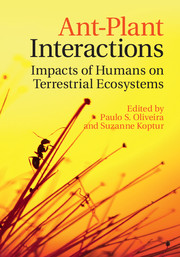Book contents
- Ant-Plant Interactions
- Ant-Plant Interactions
- Copyright page
- Contents
- Contributors
- Preface
- Part I Landscape Mosaics, Habitat Fragmentation, and Edge Effects
- Part II Ant-Seed Interactions and Man-Induced Disturbance
- 5 Global Change Impacts on Ant-Mediated Seed Dispersal in Eastern North American Forests
- 6 Effects of Human Disturbance and Climate Change on Myrmecochory in Brazilian Caatinga
- 7 Anthropogenic Disturbances Affect the Interactions between Ants and Fleshy Fruits in Two Neotropical Biodiversity Hotspots
- Part III Ant-Plant Protection Systems under Variable Habitat Conditions
- Part IV Effect of Invasive Ants on Plants and Their Mutualists
- Part V Applied Ant Ecology: Agroecosystems, Ecosystem Engineering, and Restoration
- Part VI Perspectives
- Index
- Plate section
- References
6 - Effects of Human Disturbance and Climate Change on Myrmecochory in Brazilian Caatinga
from Part II - Ant-Seed Interactions and Man-Induced Disturbance
Published online by Cambridge University Press: 01 September 2017
- Ant-Plant Interactions
- Ant-Plant Interactions
- Copyright page
- Contents
- Contributors
- Preface
- Part I Landscape Mosaics, Habitat Fragmentation, and Edge Effects
- Part II Ant-Seed Interactions and Man-Induced Disturbance
- 5 Global Change Impacts on Ant-Mediated Seed Dispersal in Eastern North American Forests
- 6 Effects of Human Disturbance and Climate Change on Myrmecochory in Brazilian Caatinga
- 7 Anthropogenic Disturbances Affect the Interactions between Ants and Fleshy Fruits in Two Neotropical Biodiversity Hotspots
- Part III Ant-Plant Protection Systems under Variable Habitat Conditions
- Part IV Effect of Invasive Ants on Plants and Their Mutualists
- Part V Applied Ant Ecology: Agroecosystems, Ecosystem Engineering, and Restoration
- Part VI Perspectives
- Index
- Plate section
- References
- Type
- Chapter
- Information
- Ant-Plant InteractionsImpacts of Humans on Terrestrial Ecosystems, pp. 112 - 132Publisher: Cambridge University PressPrint publication year: 2017
References
- 7
- Cited by

